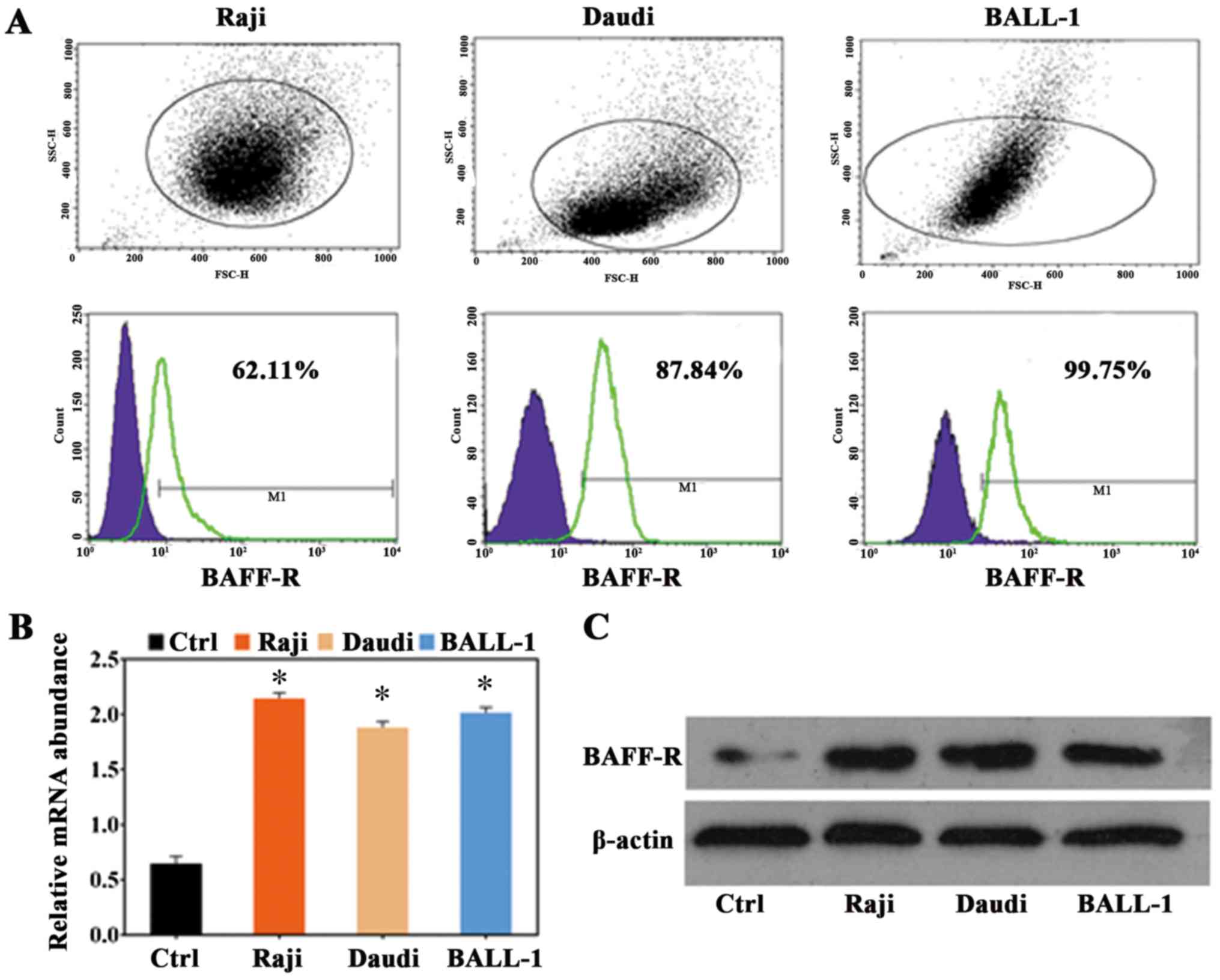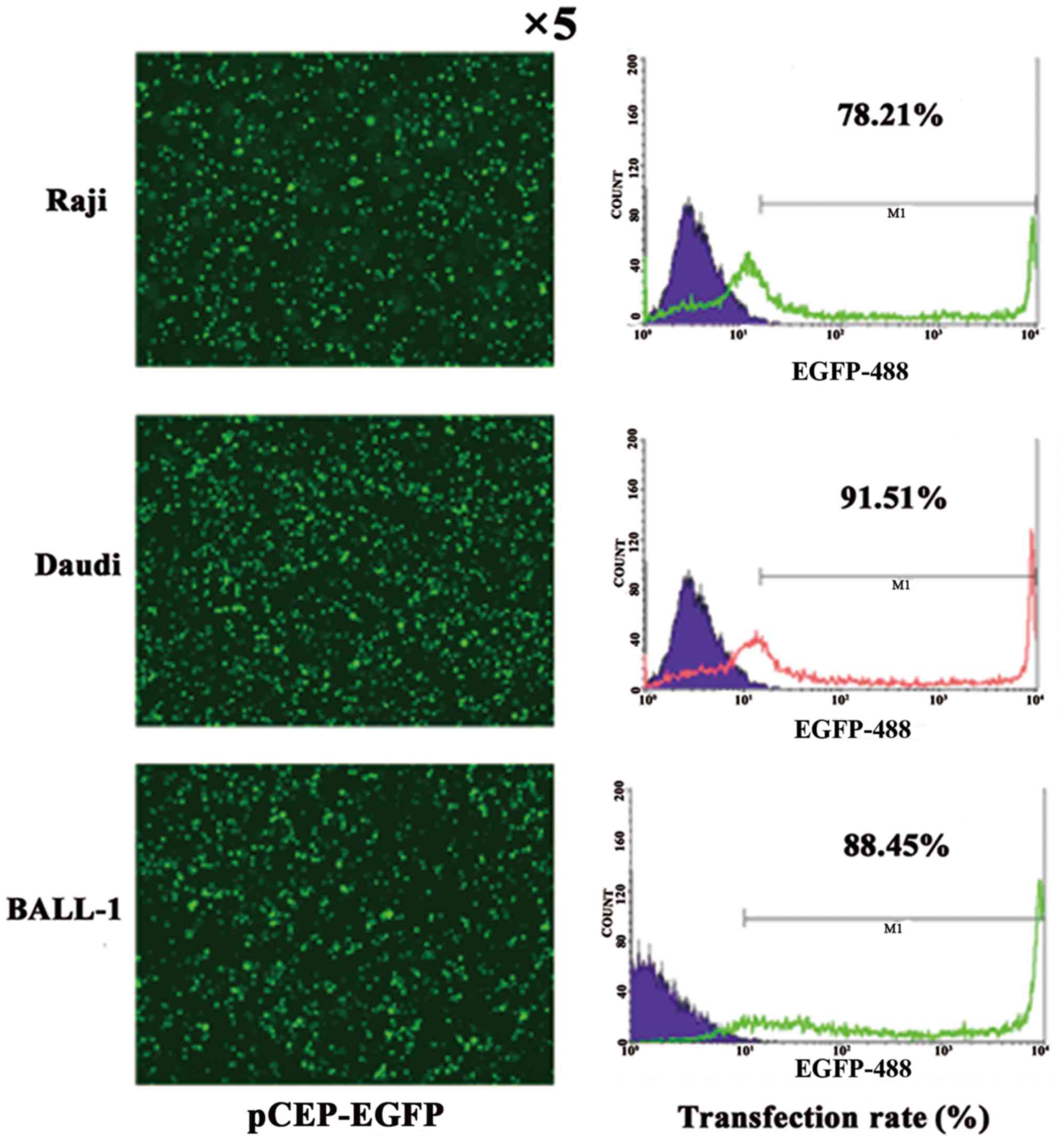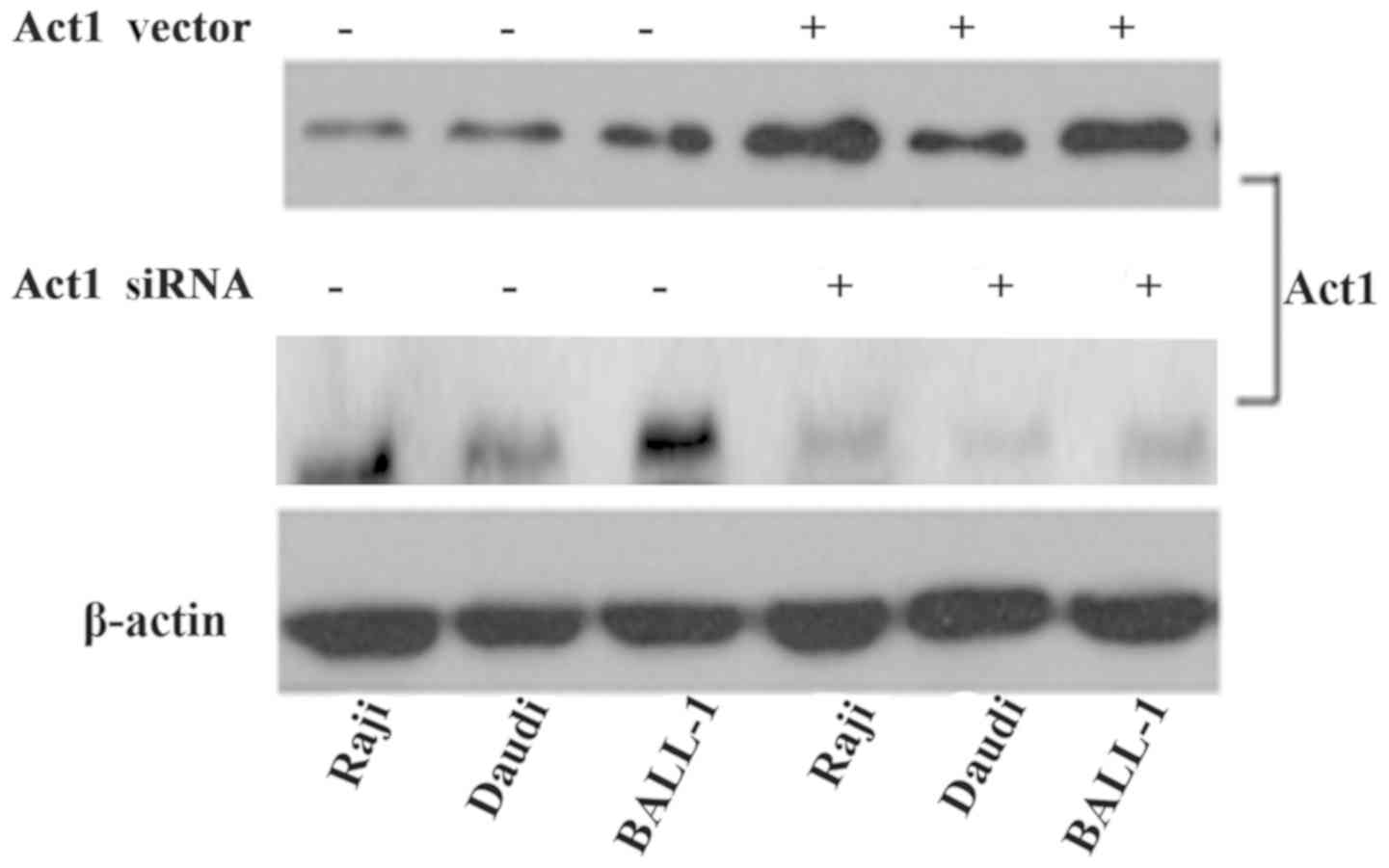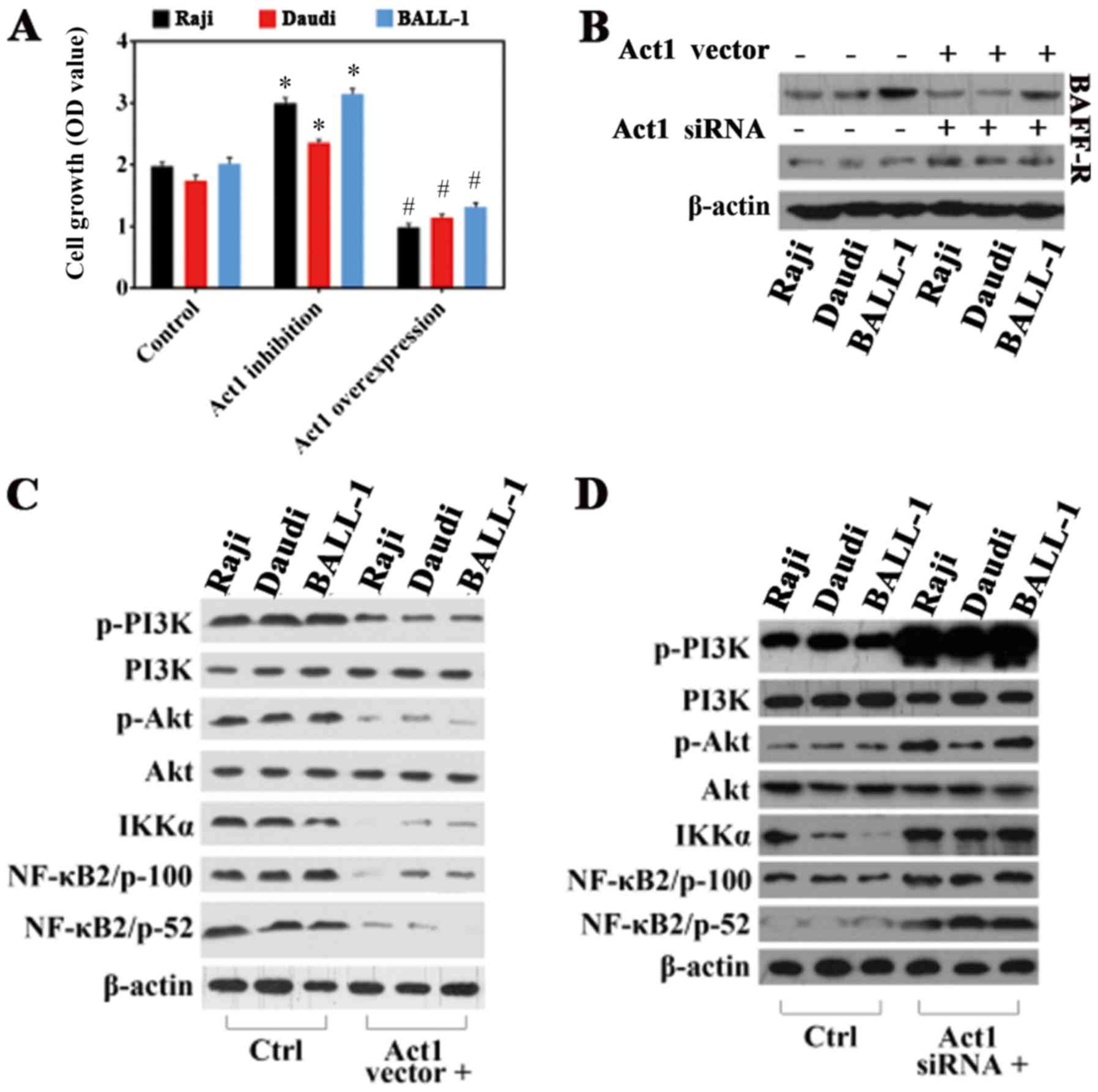Introduction
B cell-activating factor (BAFF), also known as BLys,
THANK, TALL-l, TNFsF13B or zTNF4, belongs to the tumor necrosis
factor (TNF) family discovered in 1999. It serves a critical role
in the differentiation and proliferation of B lymphocytes. By
targeting peripheral B lymphocytes, BAFF promotes the
differentiation, proliferation, antigen presentation,
immunoglobulin (Ig) class switching and gene recombination of B
lymphocytes, as well as enhancing the function of B cells, cluster
of differentiation (CD)4+ T lymphocytes and natural
killer cells, therefore triggering the immune response (1–4). A total
of three BAFF receptors (BAFF-Rs) have been identified, including
B-cell maturation antigen (BCMA), transmembrane activator CAML
interactor (TACI) and BAFF-R. These receptors are expressed in
various cells: BCMA is present in T and B cells; TAC1 in T cells;
and BAFF-R is highly expressed in the spleen and lymph nodes.
However, BAFF-R exhibits a low expression in the thymus and
peripheral blood. It has been reported that these highly specific
BAFF-Rs, which are the main receptors mediating the regulatory
effect of BAFF on B-cell differentiation, are expressed only in B
cells and specifically bind to BAFF (5,6).
Although the association between BAFF and hematological diseases
has been extensively studied, it remains unknown whether BAFF-R is
widely expressed in B-cell malignancy. In recent years, it has been
reported that BAFF works mainly via two signaling pathways, namely
the phosphoinositide 3 kinase (PI3K)/protein kinase B-mammalian
target of rapamycin (Akt-mTOR) and nuclear factor (NF)-κB p65/p50
signaling pathways (7). The NF-κB
p65/p50 signaling pathway contains a large number of signaling
molecules and a number of positive/feedback signal regulation types
are present. NF-κB Activator 1 (Act1), also known as connection to
Iκκ-complex and stress-activated protein kinases, is a
newly-discovered activator protein of the NF-κB signaling pathway
and is involved in the formation of signaling complexes in the
NF-κB and SAPK/Jun amino-terminal kinases signaling pathways
(8). Act1 negatively regulates the
NF-κB signaling pathway. Act1-deficient B cells are more sensitive
to cell proliferation induced by CD40 and BAFF, as well as
increased phosphorylation of IκB (9). Although the role of BAFF in the
pathogenesis and development of hematological diseases has been
extensively studied, whether Act1 regulates the expression of BAFF
and the consequent activity of NF-κB in B-cell malignancy has yet
to be reported. The aim of the present study was to detect the
expression of BAFF in three cell lines derived from human B-cell
malignancy. The effects of Act1 on the activity of BAFF and the
NF-κB signaling pathway were investigated by overexpressing or
silencing Act1. The results of the present study may provide a
novel insight into potential treatments for B-cell malignancy.
Materials and methods
Cell culture
The normal lymphocytes as control was separated from
XG's own peripheral blood. Inspection of certain indicators,
including blood routine and lymphocyte typing, demonstrated that XG
is healthy. All operations were carried out at the Medical Center
in The Affiliated Hospital of Zunyi Medical College (Zunyi, China).
Human B-cell cancer cell lines (Raji, Daudi and BALL-1) were
purchased from the American Type Culture Collection (ATCC;
Manassas, VA, USA). Cells were recovered from frozen liquid
nitrogen at −196°C and maintained in RPMI-1640 medium (Invitrogen;
Thermo Fisher Scientific, Inc., Waltham, MA, USA) supplemented with
10% fetal bovine serum (Gibco; Thermo Fisher Scientific, Inc.). A.
total of 100 U/ml of penicillin G sodium, and 100 µg/ml
streptomycin sulfate (Gibco; Thermo Fisher Scientific, Inc.). Cells
were incubated at 37°C in a humidified atmosphere containing 5%
CO2.
CCK-8 analysis for cell viability
Cell Counting Kit-8 (CCK-8) was used to calculate
the proliferative ability of A549 cells. Cells
(2×103/well) were seeded into 96-well plates with 100 µl
complete RPMI-1640 in triplicate for each treatment and were then
sustained in an incubator at 37°C and 5% CO2. A total of
10 µl CCK-8 solution was then added to each well and incubated for
4 h. Next, OD value was assessed by water-soluble tetrazolium salt
analysis through microplate computer software (Bio-Rad
Laboratories, Inc., Hercules, CA, USA) following the instructions
of CCK-8 analysis kit (Sigma-Aldrich; Merck KGaA, Darmstadt,
Germany). The absorbance at 450 nM (OD 450 nm) was read using a
microplate reader, and the proliferation curves were plotted.
Analysis of BAFF-R expression using
flow cytometry
For flow cytometry, 5×105 cells were
collected in the logarithmic growth phase, washed three times with
cold PBS and resuspended in PBS. The cell suspension was incubated
with the anti-BAFF-R antibody (fluorescein isothiocyanate
anti-human CD268; BioLegend, Inc., San Diego, CA, USA) for 15 min
in the dark following the manufacturer's protocols. Subsequently,
cells were washed three times with cold PBS and analyzed using a
flow cytometer BD FACSCalibur Cell Sorting System (version FACS101;
BD Biosciences, Becton, Dickinson and Company, Franklin Lakes, NJ,
USA). Unstained cells were used as a negative control.
RNA isolation and reverse
transcription-quantittive polymerase chain reaction (RT-qPCR)
Total RNA was extracted from cells using the RNA PCR
kit (AMV), version 3.0 (Takara Bio, Inc., Otsu, Japan) following
the manufacturer's protocols. The cDNA synthesis reaction mixture
(total volume of 30 µl) was prepared using 6.0 µl of 5X Prime
Script™ Buffer, 1.5 µl of PrimeScript™ RT Enzyme Mix, 1.5 µl of
random hexamers (100 µmol/l), 1.5 µl of oligo(dT) primers (50
µmol/l) and 19.5 µl of total RNA. Reverse transcription was
performed at 37°C for 15 min followed by heating at 85°C for 5 sec
to inactivate the enzyme. For qPCR (Sso Advanced SYBR-Green
SuperMix; Bio-Rad Laboratories, Inc.), the 20 µl reaction mixture
contained 1 µl of cDNA, 10 µl of SYBR® Premix Ex Taq™, 1
µl of the primer mixture and 8 µl of 1% DEPC water. Amplification
was performed using the CFX96™ PCR system (Bio-Rad Laboratories,
Inc.) and conditions were as follows: Initial denaturation at 95°C
for 30 sec followed by 40 cycles of 95°C for 5 sec, 60°C for 30 sec
and 72°C for 40 sec. The primers for BAFF-R and β-actin were:
BAFF-R forward, [22 base pairs (bp)] 5′-AATCTCTGATGCCACAGCTCCT-3′,
BAFF-R and reverse, (19 bp) 5′-TATTGTTGCTCAGGGCCGG-3′; β-actin
forward, (20 bp) 5′-CCACGAAACTACCTTCAACTCC-3′ and β-actin reverse,
(20 bp) 5′-GTGATCTCCTTCTGCATCCTGT-3′. Relative expression was
calculated using the 2−ΔΔCq method (10).
Construction of the pTT5-Act1
expression plasmid
Due to its ability to express foreign proteins, pTT5
(ATCC) was used to generate the overexpressed plasmid coding for
the Act1 fragment coding sequence (CDS; 1,609 bp) and cloning was
performed between the HindIII and NotI restriction
sites. Total RNA was extracted from Raji cells using TRIzol
(Invitrogen; Thermo Fisher Scientific, Inc.) according to the
manufacturer's protocol and reverse transcribed into cDNA, as
aforementioned, with the Reverse Transcriptase Moloney Murine
Leukemia Virus (Takara Bio, Inc.). RNA was assessed by
electrophoresis on a 0.5% denaturing agarose gel. The specific Act1
primers were: Sense, 5′-CCCAAGCTTTTGATCTTACTTGGCTTCGTAA-3′ and
antisense, 5′-AACGCCGGCGTCACAAGGGAACCACCTGAACGG-3′. A total of 30
µl reaction mixture containing 1 µg of plasmid DNA (pTT5), 1.5 µl
of HindIII/NotI, 3 µl of 10X FD buffer (Takara Bio,
Inc.) and ddH2O. The mixture was incubated at 37°C for 2
h and heated at 80°C for 10 min to inactivate the endonuclease
enzyme.
The DNA ligase reaction mixture contained 50 ng of
linearized vector, 40 ng of the target gene, 2.0 µl of 10X T4
ligase buffer, 0.2 µl of T4 DNA ligase and ddH2O to give
a total volume of 20 µl. The mixture was gently pipetted and
incubated at 22°C for 30 min, heated to 70°C for 5 min to inactive
the enzyme and chilled to 4°C.
Cell transfection
Three types of B lymphoma cells in logarithmic
growth were collected. In a 10-cm dish, 1×106 cells were
seeded and cultured for 6 h at 37°C. The medium was then replaced
with serum-free RPMI-1640 to starve the cells overnight. Cells were
then maintained in fresh RPMI-1640 medium. Next, 2 µl of
polyethylenimine (PEI; 1 mg/ml, pH=7.0, Sigma-Aldrich; Merck KGaA)
and 2 µl of plasmid DNA were separately added to 100 µl of the cell
suspension and mixed immediately by vortexing or pipetting. The
mixture was incubated for 15 min at room temperature, added to the
cells and maintained at 37°C. The supernatant from the transfected
cells was harvested 48 h post-transfection. The cell transfection
efficiency was evaluated using fluorescence microscopy (Leica DMi8;
Leica Microsystems GmbH, Wetzlar, Germany) to observe the green
fluorescence protein intensity and flow cytometry to detecte
fluorescent signal.
Western blotting
Three types of B lymphoma cells in the logarithmic
growth phase were harvested, washed three times with PBS and
suspended in radioimmunoprecipitation assay lysis buffer (150 mM
NaCl, 1% NP-40, 50 mM Tris-HCl pH 7.4, 1 mM phenylmethylsulfonyl
fluoride, 1 µg/ml leupeptin, 1 mM deoxycholic acid and 1 mM EDTA)
on ice for 30 min, followed by centrifugation at 26,475 × g for 30
min at 4°C. Proteins in the supernatant were collected, quantified
using a MiniDrop 2000 (Merck KGaA) and stored at −70°C. Protein
samples were mixed with loading buffer at a ratio of 1:4 and heated
at 80°C for 3–8 min. Next, 10–20 µl of the protein samples were
separated by 10% SDS-PAGE and transferred onto polyvinylidene
fluoride (PVDF) membranes (EMD Millipore, Billerica, MA, USA). PVDF
membranes were blocked with 5% reconstituted dry milk at 37°C for 2
h and incubated with the primary antibody [AKT (cat. no.
4691,C67E7)/phosphorylated (P)-AKT (cat. no. 13083, Thr308)/ERK1/2
(cat. no. 4695, 137F5)/P-ERK1/2 (cat. no. 9101, Thr202/Thr204);
Cell Signaling Technology, Inc., Danvers, MA, USA; 1:500 to
1:1,500] at 4°C overnight, followed by incubation with horseradish
peroxidase-conjugated goat anti-mouse IgG (cat. no. 4410) and goat
anti-rabbit IgG secondary antibodies (cat. no. 4414; Cell Signaling
Technology, Inc.; 1:10,000) at room temperature for 1 h. Membranes
were washed three times with TBS with 0.05% Tween-20 and the
results were recorded by chimiDOC Touch Imaging (LI-COR; Bio-Rad
Laboratories, Inc.), which is a bioimaging system (Bio-Rad
Laboratories, Inc.). Protein expression levels were evaluated using
β-actin (cat. no. 13E5) as a loading control (Cell Signaling
Technology, Inc.; 1:500 to 1:1,500).
Statistical analysis
All experiments were repeated at least three times.
Experimental data was presented as mean ± stand error of mean or in
percentages. Comparison between different experimental groups was
performed with the two-tailed Student's t-test and multiple group
comparisons used one-way analysis of variance followed by Tukey's
post hoc test. All analyses were performed using SPSS version 13.0
(SPSS, Inc., Chicago, IL, USA). P<0.05 was considered to
indicate a statistically significant difference.
Results
BAFF-R is upregulated in B-cell cancer
cell lines
Flow cytometry was performed to assess the presence
of BAFF-R in three cell lines of B-cell malignancy (Raji, Daudi and
BALL-1; Fig. 1A). To confirm the
expression of BAFF-R at the transcriptional level, normal B cells
(obtained by the BD company's method of immunomagnetic beads
separation from healthy people) were selected in the present study
as a control (the study was approved by the Medical Ethics
Committee of Affiliated Hospital of Zunyi Medical University)
BAFF-R expression in the three cell lines of B-cell malignancy was
significantly increased compared with the normal B cells
(P<0.05; Fig. 1B). BAFF-R protein
levels were considerably increased in Raji, Daudi and BALL-1 cells
compared with the normal B cells (Fig.
1C). This suggests an association between BAFF-R expression and
the occurrence of B-cell malignancy.
Construction of the pTT5-Act1
expression plasmid
As presented in Fig.
2A, RNA was assessed by electrophoresis on a denaturing agarose
gel. DNA fragments from Act1 and pTT5 were purified by gel
extraction following digestion by two restriction enzymes (Fig. 2B). Following the ligation reaction, a
vector expressing Act1 CDS sequences was identified (Fig. 2C). At 48 h following transfection,
the pTT5-Act1 expression plasmid was verified by restriction
endonuclease digestion using agarose gel electrophoresis (Fig. 2D).
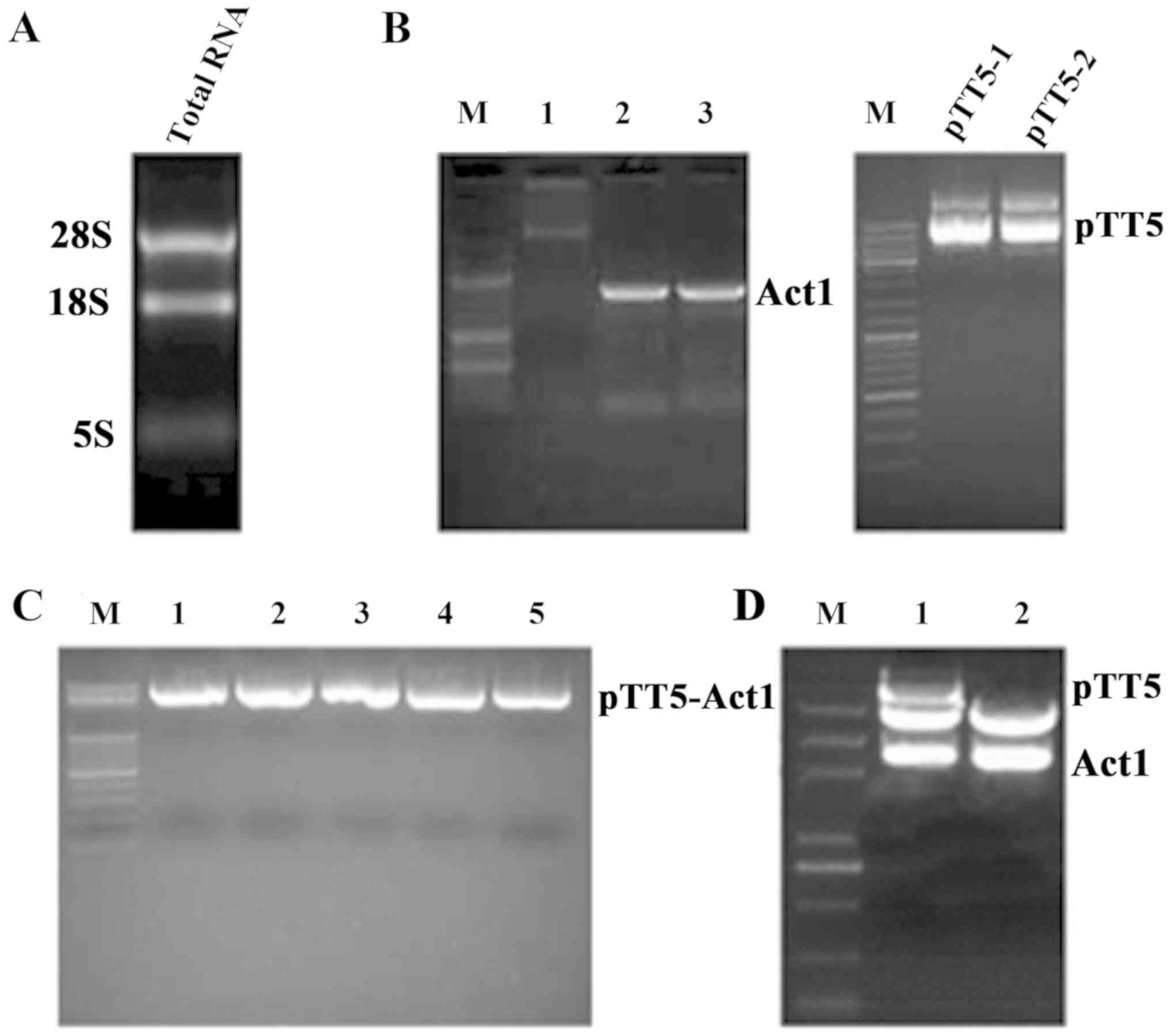 | Figure 2.pTT5-Act1 expression vector
construction. (A) Total RNA extraction from Raji cells. (B) A gel
extraction kit was used to purify cDNA fragments of Act1 and pTT5
following dual restriction enzyme digestion (M, Marker; 1, 2 and 3,
polymerase chain reaction products of Act1). (C) Construction of
the pTT5-Act1 expression vector (M, Marker; 1, 2, 3 and 5,
recombinant plasmid of pTT5-Act1). (D) A positive clone of
pTT5-Act1 was verified using dual digestion (M, Marker; 1 and 2,
sequences of pTT5 and Act1). Act1, nuclear factor-κB Activator
1. |
Transfection efficiency in cell
lines
Suspended cells were transfected with the pCEP4-EGFP
using 25 kDa PEI with the polymer/DNA ratio (N/P) ratio of 25. The
transfection efficiency was characterized by green fluorescence
protein intensity via fluorescence microscopy and flow cytometry
measurement, respectively. As presented in Fig. 3 and Table
I, successful transfection was observed in all three cell lines
of B-cell malignancy.
 | Table I.Results of the flowcytometry analysis
of the transfection efficiency of polyethylenimine. |
Table I.
Results of the flowcytometry analysis
of the transfection efficiency of polyethylenimine.
| Cell line | Transfection
efficiency (%) |
|---|
| Raji | 78.21 |
| Daudi | 91.51 |
| BALL-1 | 88.45 |
Overexpression and silencing of
Act1
To investigate the effect of Act1 in human B-cell
malignancy, a eukaryotic expression plasmid was constructed and
transfected into B-cell cancer cells to transiently overexpress
Act1 and Act1 expression in B-cell malignancy cells was transiently
silenced by small interfering (si)RNA transfection. The effects of
Act1 expression on the NF-κB pathway were then studied. It was
experimentally determined whether Act1 overexpression/silencing was
successful. Under normal circumstances, self-designed siRNA
sequences are synthesized by entrusted companies and the silencing
efficiency is verified in pairs. However, the Act1 siRNA reagent
used in the present study was an advanced product ordered from
Santa Cruz Biotechnology, Inc. (Dallas, TX, USA) with a relatively
high silencing efficiency (the sequences of these siRNAs were
unknown) and the screening and optimization of the siRNA sequences
were omitted.
As presented in Fig.
4, the expression of Act1 in B-cell malignancy cells was
determined using western blotting. The results demonstrated that
Act1 protein in Raji, Daudi and BALL-1 cell lines was effectively
upregulated by transfection with Act1-expressing plasmids and
effectively disrupted by Act1 siRNA interference.
Act1 silencing and overexpression in
human B-cell lymphoma cell lines
Act1 was overexpressed or silenced in Raji, Daudi
and BALL-1 cell lines to further investigate the regulatory role of
Act1 in the growth of B-cell malignancies, and cell proliferation
following the overexpression and silencing of Act1 was determined
using the CCK-8 cell proliferation assay. The results demonstrated
that the proliferation of B-cell malignancy cells was increased
following Act1 silencing and inhibited following Act1
overexpression (Fig. 5A). The
expression of BAFF-R protein and relevant signaling proteins in the
NEMO-independent NF-κB signaling pathway were detected using
western blotting. The results revealed that Act1 was able to
regulate the expression of BAFF-R in all three cell lines (Fig. 5B). In addition, the expression of
NEMO-independent NF-κB pathway-associated proteins, including PI3K,
Akt, IKKα, NF-κB2/p-100 and NF-κB2/p-52, was downregulated
following Act1 overexpression (Fig.
5C) and upregulated following Act1 silencing (Fig. 5D). These results suggest that Act1
regulates the proliferation of Raji, Daudi and BALL-1 cell lines by
targeting the BAFF and the NF-κB signaling pathways in these
cells.
Discussion
NF-κB Activator 1 (Act1) is a recently identified
activator protein in the NF-κB signaling pathway that comprises
multiple domains with 574 amino acids. Act1 is widely expressed in
various tissues and organs, including the thymus, heart, lungs,
liver, kidney, colon and placenta, and serves an important role in
regulating the immune response of T and B cells (10). Previous studies have demonstrated
that Act1 is an important factor in the immune-associated
interleukin (IL)-17 signaling pathway, interacting with TNF
receptor associated factor 4 (TRAF) molecules (11,12).
Act1 also serves a negative regulatory role in the
CD-40L/BAFF-R-mediated activation of B lymphocytes (13). As such, Act1 regulates the signaling
pathways and cell proliferation of cells in two distinct ways.
The proliferation and metastasis of B-cell cancer
cells are regulated by the BAFF signaling pathway. BAFF exists in
membranous and soluble forms in vivo. Membranous BAFF is
expressed in myeloid-derived cells, including dendritic cells, T
cells and macrophages and is stimulated and regulated by
interferon-γ and IL-10. The peptide bond between amino acids
133–134 in the extracellular domain of membranous BAFF can be
hydrolyzed by proteases to give soluble BAFF. The extracellular
domain of BAFF is a conserved domain containing ~150 amino acids,
which forms a β-sheet trimer and binds to BAFF-Rs on the surface of
cells (14). A total of three
BAFF-Rs have been identified, namely the BCMA, the TACI and the
recently identified BAFF-R. These receptors are expressed in
various cells, i.e., BCMA is present in T cells and B cells; TAC1
is in T cells; and BAFF-R is highly expressed in spleen and lymph
nodes but with a low expression in the thymus and peripheral blood.
Studies (15–17) have demonstated that these highly
specific BAFF-Rs specifically bind to BAFF, but not to other
members of the TNF family and are the principal receptors mediating
the regulatory effect of BAFF on B cell differentiation (18). Abundant evidence has demonstrated
that BAFF serves an important role in regulating the growth and
differentiation of B cells. Schneider et al (19) found that BAFF stimulated the growth
of B cells. Schiemann et al (20) also demonstrated that BAFF serves a
key role in the growth of B cells via a BCMA-independent signaling
pathway. Claudio et al (21)
demonstrated that BAFF regulates B cell maturation via the
NEMO-independent NF-κB2 pathway. In the present study, associated
studies (22–24) demonstrated that the expression of
BAFF-R in the B malignancy cells can be detected and BAFF can
promote cell proliferation, however how Act1 affects the expression
of BAFF and regulates of the growth of B-cell malignancy has not
yet been reported. Therefore, three B malignancy cell lines were
selected for the functional study, including Raji, Daudi (derived
from Burkitt's lymphoma) and BALL-1 (derived from acute
lymphoblastic leukemia), they are standard cell lines for B-cell
malignancy research and have been widely used in previous studies
(25–30). The purpose of the present study was
to investigate the association between Act1 and B-cell malignancy
by overexpressing and silencing Act1. The results revealed that the
proliferation of these cell lines was increased by Act1 silencing
and inhibited by the overexpression of Act1, suggesting that Act1
may serve a negative role in regulating the proliferation of B-cell
cancer. Furthermore, the expression of BAFF-R and associated
signaling proteins in the NEMO-independent NF-κB signaling pathway
in these cell lines was detected using western blotting, and the
results revealed that Act1 negatively regulated BAFF-R expression.
Western blotting also demonstrated that NEMO-independent NF-κB
signaling pathway associated proteins, including PI3K, Akt, IKKα,
NF-κb2/p-100 and NF-κb2/p-52, were downregulated following Act1
overexpression and were upregulated following Act1 silencing. These
results suggest that Act1 controlled the proliferation of the Raji,
Daudi and BALL-1 cell lines by regulating the BAFF and NF-κB
signaling pathways. In conclusion, the results of the present study
confirmed the high expression of BAFF-R in three human cell lines
of B-cell cancer, Raji, Daudi and BALL-1, suggesting that the BAFF
pathway is associated with the proliferation of B-cell malignancy
cells. Act1 overexpression led to BAFF-R downregulation, while Act1
silencing resulted in BAFF-R upregulation. Furthermore, Act1
negatively regulated the activity of the NF-κB signaling pathway in
B-cell malignancy cell lines. The results of the present study
suggest that Act1 serves a negative regulatory role in B-cell
malignancy cells, suggesting that Act1 may serve as a possible
therapeutic target with potential value for future development.
Acknowledgements
Not applicable.
Funding
The present study was supported by the National
Nature Science Foundation of China (grant no. 81560487).
Availability of data and materials
All data generated or analyzed during this study are
included in this published article.
Authors' contributions
XJG and YLW contributed to the study design and
major laboratory work. YPW and ZXF contributed to the data analysis
and data interpretation. LL, MYL and JYJ contributed to the total
RNA extraction, protein extraction, cell culture and RNA
interference. All authors read and approved the manuscript and
agree to be accountable for all aspects of the research in ensuring
that the accuracy or integrity of any part of the work are
appropriately investigated and resolved.
Ethics approval and consent to
participate
The present study was approved by the Medical Ethics
Committee of Affiliated Hospital of Zunyi Medical University (the
reference number is 56). The normal lymphocytes used came from XG's
own peripheral blood. Inspection of certain indicators, including
blood routine and lymphocyte typing, demonstrated that XG is
healthy. XG volunteered for the research and signed a consent form.
All operations were carried out at the medical center in the
affiliated hospital of Zunyi Medical College (Zunyi, China).
Patient consent for publication
Written informed consent for publication was
obtained.
Competing interests
The authors declare that they have no competing
interests.
References
|
1
|
Assi LK, Wong SH, Ludwig A, Raza K, Gordon
C, Salmon M, Lord JM and Scheel-Toellner D: Tumor necrosis factor
alpha activates release of B lymphocyte stimulator by neutrophils
infiltrating the rheumatoid joint. Arthritis Rheum. 56:1776–1786.
2007. View Article : Google Scholar : PubMed/NCBI
|
|
2
|
Jian S, Lin Z, Feng J, Li Y and Shen B:
BAFF-targeting therapy, a promising strategy for treating
autoimmune diseases. Eur J Pharmacol. 597:1–5. 2008. View Article : Google Scholar : PubMed/NCBI
|
|
3
|
Xiao Y, Motomura S and Podack ER: APRIL
(TNFSF13) regulates collagen-induced arthritis, IL-17 production
and Th2 response. Eur J Immunol. 38:3450–3458. 2008. View Article : Google Scholar : PubMed/NCBI
|
|
4
|
Shan X, Chen L, Cao M, Xu L and Zhang S:
Effects of human soluble BAFF synthesized in Escherichia
coli on CD4+ and CD8+ T lymphocytes as
well as NK cells in mice. Physiol Res. 55:301–307. 2006.PubMed/NCBI
|
|
5
|
Kothlow S, Morgenroth I, Graef Y,
Schneider K, Riehl I, Staeheli P, Schneider P and Kaspers B: Unique
and conserved functions of B cell-activating factor of the TNF
family (BAFF) in the chicken. Int Immunol. 19:203–207. 2007.
View Article : Google Scholar : PubMed/NCBI
|
|
6
|
Sjöstrand M, Johansson A, Aqrawi L, Olsson
T, Wahren- Herlenius M and Espinosa A: The expression of BAFF is
controlled by IRF transcription factors. J Immunol. 196:91–97.
2016. View Article : Google Scholar : PubMed/NCBI
|
|
7
|
Yang S, Li JY and Xu W: Role of
BAFF/BAFF-R axis in B-cell non-Hodgkin lymphoma. Crit Rev Oncol
Hematol. 91:113–122. 2014. View Article : Google Scholar : PubMed/NCBI
|
|
8
|
Leonardi A, Chariot A, Claudio E,
Cunningham K and Siebenlist U: CIKS, a connection to Ikappa B
kinase and stress-activated protein kinase. Proc Natl Acad Sci USA.
97:10494–10499. 2000. View Article : Google Scholar : PubMed/NCBI
|
|
9
|
Lin WW: TRAF3 regulates B cell survival
and IL-6 receptor signaling. PhD dissertation. University of Iowa.
doi 10.17077/etd.3jo8jplz. 2015
|
|
10
|
Livak KJ and Schmittgen TD: Analysis of
relative gene expression data using real-time quantitative PCR and
the 2−ΔΔCT method. Methods. 25:402–408. 2001. View Article : Google Scholar : PubMed/NCBI
|
|
11
|
Li X: Act1 modulates autoimmunity through
its dual functions in CD40L/BAFF and IL-17 signaling. Cytokine.
41:105–113. 2008. View Article : Google Scholar : PubMed/NCBI
|
|
12
|
Swaidani S, Bulek K, Kang Z, Liu C, Lu Y,
Yin W, Aronica M and Li X: The critical role of epithelial-derived
Act1 in IL-17- and IL-25-mediated pulmonary inflammation. J
Immunol. 182:1631–1640. 2009. View Article : Google Scholar : PubMed/NCBI
|
|
13
|
Wu L, Zepp J and Li X: Function of Act1 in
IL-17 family signaling and autoimmunity. Adv Exp Med Biol.
946:223–235. 2012. View Article : Google Scholar : PubMed/NCBI
|
|
14
|
Giltiay NV, Yi L, Allman D, Jørgensen TN
and Li X: The adaptor molecule Act1 regulates BAFF responsiveness
and self-reactive B cell selection during transitional B cell
maturation. J Immunol. 185:99–109. 2010. View Article : Google Scholar : PubMed/NCBI
|
|
15
|
Hase H, Kanno Y, Kojima M, Hasegawa K,
Sakurai D, Kojima H, Tsuchiya N, Tokunaga K, Masawa N, Azuma M, et
al: BAFF/BLyS can potentiate B-cell selection with the B-cell
coreceptor complex. Blood. 103:2257–2265. 2004. View Article : Google Scholar : PubMed/NCBI
|
|
16
|
Yang L, Zhou L, Zong X, Cao X, Ji X, Gu W
and Zhang S: Characterization of the molecular structure,
expression and bioactivity of the TNFSF13B (BAFF) gene of the South
African clawed frog, Xenopus laevis. Int Immunopharmacol.
15:478–487. 2013. View Article : Google Scholar : PubMed/NCBI
|
|
17
|
Faustova M, Plestilova L, Hulejova H,
Pecha O, Mann H, Putova J, Vencovsky J, Vencovsky J, Novota P and
Krystufkova O: A7.11 genetic variation in promoter sequence of
B-cell-activating factor of the TNF family (BAFF) in patients with
idiopathic inflammatory myopathies (IIM). Ann Rheumat Dis.
72:A512013. View Article : Google Scholar
|
|
18
|
Thompson JS, Bixler SA, Qian F, Vora K,
Scott ML, Cachero TG, Hession C, Schneider P, Sizing ID, Mullen C,
et al: BAFF-R, a newly identified TNF receptor that specifically
interacts with BAFF. Science. 293:2108–2111. 2001. View Article : Google Scholar : PubMed/NCBI
|
|
19
|
Schneider P, Takatsuka H, Wilson A, Mackay
F, Tardivel A, Lens S, Cachero TG, Finke D, Beermann F and Tschopp
J: Maturation of marginal zone and follicular B cells requires B
cell activating factor of the tumor necrosis factor family and is
independent of B cell maturation antigen. J Exp Med. 194:1691–1097.
2001. View Article : Google Scholar : PubMed/NCBI
|
|
20
|
Schiemann B, Gommerman JL, Vora K, Cachero
TG, Shulga-Morskaya S, Dobles M, Frew E and Scott ML: An essential
role for BAFF in the normal development of B cells through a
BCMA-independent pathway. Science. 293:2111–2114. 2001. View Article : Google Scholar : PubMed/NCBI
|
|
21
|
Claudio E, Brown K, Park S, Wang H and
Siebenlist U: BAFF-induced NEMO-independent processing of NF-kappa
B2 in maturing B cells. Nat Immunol. 3:958–965. 2002. View Article : Google Scholar : PubMed/NCBI
|
|
22
|
Secreto F, Manske M, Price-Troska T,
Ziesmer S, Hodge LS, Ansell SM, Cerhan JR and Novak AJ: BAFF-R
specific activation of TRAF6 and the PI3K-pathway in lymphoma B
cells. Leuk Lymphoma. 55:1884–1892. 2014. View Article : Google Scholar : PubMed/NCBI
|
|
23
|
Wu H, Chen S, Liu M, Xu X, Gao K, Tian A,
Ke Z, Zhang J, Zhao B and Zhang S: Molecular characterization and
evolutionary analysis of horse BAFF-R, a tumor necrosis factor
receptor related to B-cell survival. Int Immunopharmacol.
18:163–168. 2013. View Article : Google Scholar : PubMed/NCBI
|
|
24
|
Wang Y, Li YJ, Jiang WQ, Rao HL, Huang JJ,
Xia Y, Bi X, Sun P, Huang HQ, Lin TY, et al: Expression of BAFF-R,
but not BAFF, is an independent prognostic factor in diffuse large
B-cell lymphoma patients treated with R-CHOP. Ann Hematol.
94:1865–1873. 2015. View Article : Google Scholar : PubMed/NCBI
|
|
25
|
Ohba H and Bakalova R: Relationships
between degree of binding, cytotoxicity and cytoagglutinating
activity of plant-derived agglutinins in normal lymphocytes and
cultured leukemic cell lines. Cancer Chemother Pharmacol.
51:451–458. 2003.PubMed/NCBI
|
|
26
|
Care MA, Cocco M, Laye JP, Barnes N, Huang
Y, Wang M, Barrans S, Du M, Jack A, Westhead DR, et al: SPIB and
BATF provide alternate determinants of IRF4 occupancy in diffuse
large B-cell lymphoma linked to disease heterogeneity. Nucleic
Acids Res. 42:7591–7610. 2014. View Article : Google Scholar : PubMed/NCBI
|
|
27
|
Nicholas NS, Apollonio B and Ramsay AG:
Tumor microenvironment (TME)-driven immune suppression in B cell
malignancy. Biochim Biophys Acta. 1863:471–482. 2016. View Article : Google Scholar : PubMed/NCBI
|
|
28
|
Lindqvist CA and Loskog AS: T regulatory
cells in B-cell malignancy-tumour support or kiss of death?
Immunology. 135:255–260. 2012. View Article : Google Scholar : PubMed/NCBI
|
|
29
|
Fidanza M, Seif AE, DeMicco A, Rolf N, Jo
S, Yin B, Li Y, Barrett DM, Duque-Afonso J, Cleary ML, et al:
Inhibition of precursor B-cell malignancy progression by toll-like
receptor ligand-induced immune responses. Leukemia. 30:2116–2119.
2016. View Article : Google Scholar : PubMed/NCBI
|
|
30
|
Abolhassani H, Edwards ES, Ikinciogullari
A, Jing H, Borte S, Buggert M, Du L, Matsuda-Lennikov M, Romano R,
Caridha R, et al: Combined immunodeficiency and Epstein-Barr
virus-induced B cell malignancy in humans with inherited CD70
deficiency. J Exp Med. 214:91–106. 2017. View Article : Google Scholar : PubMed/NCBI
|















